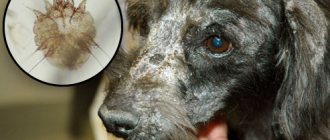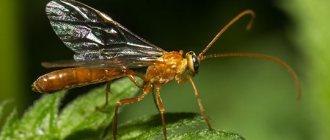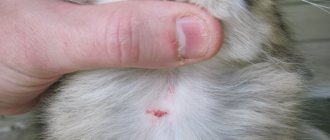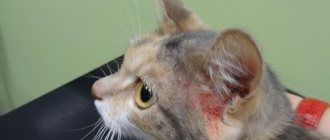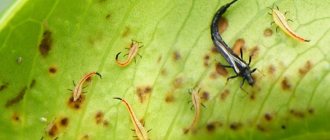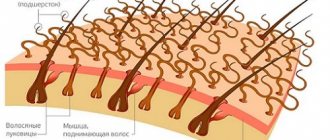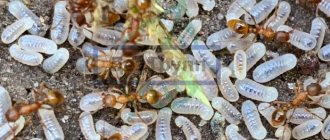Subcutaneous parasites can cause a lot of trouble and cause serious complications that are dangerous to health. Parasites can enter the human body and live anywhere - in internal organs, muscles, skin. An extremely common option is parasites that burrow under the skin. What diseases do subcutaneous parasites cause in humans, what complications can they cause and how to get rid of them - let’s try to figure it out.
The invisible enemy
There are a lot of parasites that affect the skin. They can be cutaneous or subcutaneous. Cutaneous lice include common lice, bedbugs, and fleas. But parasites living on human skin do not cause disease and simply feed on human blood.
Much more unpleasant and dangerous are those parasites that penetrate into the thickness of the skin. At the same time, they not only feed on it, but also use it to breed offspring. Getting rid of them is much more difficult than getting rid of cutaneous ones.
It is very important to diagnose the disease as early as possible and begin its treatment.
Such creatures living under the skin lead to the development of parasitic dermatoses.
These include:
- filariasis;
- scabies;
- dracunculiasis;
- hookworm disease;
- schistosomiasis;
- cysticercosis.
Some protozoa, such as Trichomonas, can also cause skin lesions. Such dermatoses have to be treated long and hard - the main problem here is to make the correct diagnosis. And diagnosis is often difficult, since the symptoms of diseases may resemble damage to internal organs or an allergic reaction.
What does a parasite look like?
The average size of an adult gadfly is up to 2 centimeters. Visually, the parasite resembles a small bumblebee. Its body is shaggy, and its color has bright orange notes.
The insect's head is quite large. The eyes are large and shiny. The tint of the belly is bluish. The gadfly has small transparent wings.
Note! In domestic spaces, especially in rural areas, you can also find gadflies.
The appearance of the most dangerous fly is quite specific.
They prefer to bite cattle. Flies rarely attack humans. The insect is unique in that it does not require nutrition in adult life. It receives the entire supply of important substances at the time of development. This is enough for him for the rest of his life.
The larva of this fly at the very beginning of its development is tiny in size. It is growing gradually. The body is oblong, its shape is drop-shaped.
Order an antiparasitic drug directly from the manufacturer
It has special hairs - hooks. Thanks to them, it has the ability to cling to the skin of both animals and people.
Gadflies are very prolific. During her life, one female can reproduce up to 660 eggs. Fortunately for living creatures suffering from them, only 18% of them are viable.
Dracunculiasis - unpleasant cyclops
This parasite is otherwise called Guinea worm. Dracunculiasis is caused by round subcutaneous helminths, which in adulthood can be frightening in size. Females of Dracunculus medinensis grow to 32–120 cm as adults.
In addition to humans, they can parasitize dogs and cats. In Eurasia, guinea worm is found in Central Asia. But most often it is typical for countries with a tropical climate. This is where tourists get infected.
This parasite is otherwise called Guinea worm. Dracunculiasis is caused by round subcutaneous helminths, which in adulthood can be frightening in size
They enter the body along with raw water. After 1–2 weeks, the larvae begin to move through the body and after 48 days they enter the subcutaneous areas. Full development of individuals occurs after a year. Most often, these parasites settle in the leg area.
As a result of the vital activity of the larvae, a swollen ridge in the form of a cord forms on the skin, and then a bubble that can grow up to 7 cm. It can burst if it comes into contact with water, and then new larvae appear.
Complications of the disease are:
- development of contractures (immobility) of joints;
- joint inflammation;
- gangrene;
- blood poisoning - sepsis.
Due to the spread of infection, abscesses and phlegmons can form on the skin, which easily lead to general blood poisoning.
Treatment: to get rid of guinea worm, you need to remove the parasite from the skin tissue. However, it can be removed in several stages if its length is very large. The main thing is not to tear the parasite.
How to avoid getting sick: do not drink from open sources of water and avoid swimming in ponds.
How does the larva develop?
The duration of the first stage is 1.5-2.5 months. Having penetrated inside a person, it begins to feed on blood. All useful substances that are intended for humans ultimately go to the bloodsucker.
Within a few weeks, the pest increases in size 10 times or more. The size of a mature larva is 20 millimeters.
Order an antiparasitic drug directly from the manufacturer
Baby gadfly is very dangerous
When the pest collects the supply of nutrients it needs from the host’s body, what most people are used to seeing in horror films happens: the insect breaks through the skin and crawls out.
Then comes the time of the second stage - pupation. Its duration varies from 15 to 30 days. Then its gradual transformation into an adult is observed.
Life cycle – 3 weeks. The insect is the most zealous supporter of the biblical principle: “Be fruitful and multiply.” It takes him his entire short life to reproduce.
Order an antiparasitic drug directly from the manufacturer
Dirophyllaria: a ticking time bomb
Parasites that live under human skin are considered extremely unpleasant, capable of settling not only under the skin, but also in the eyes. This is the so-called dirofilaria, the females of which reach a length of 15–30 cm, and the males 5–10.
Infection occurs through mosquitoes. The fact is that the carriers of parasites are dogs and cats, and the carriers are mosquitoes, which, by biting dogs, transfer microfilariae larvae from them to humans. Full development already occurs under human skin, which takes a very long time - the incubation period can last several years.
Heartworms settle under the skin. But sometimes they can live in the eyes, leading to visual impairment and even blindness.
Heartworms settle under the skin. But sometimes they can live in the eyes, leading to visual impairment and even blindness. It is believed that in 1/6 of all cases of removal of the eyeball it is due to damage by this parasite. Under the skin, due to the penetration of the larva, a compaction is formed, which gradually grows and can take on the size of an egg. The seal turns red and itches. It contains a folded heartworm.
Treatment: the abscess is opened surgically.
How to avoid getting sick: you need to use repellents.
Establishing a diagnosis
If a person suspects he is infected, he should seek help from a good parasitologist or infectious disease specialist.
The patient is sent for a general blood test
The doctor sends the patient for a blood test, which determines the amount of antibodies. The specialist undertakes to find out from his client whether he has been to African countries or other places where the terrible gadfly lives.
A visual inspection is required. If infection occurs, an abscess with a fairly large hole forms on the cover.
Inspection is carried out using a special magnifying glass.
Scabies mite: a well-forgotten old thing
The scabies mite causes scabies, a disease that was well known 50 years ago.
The Sarcoptes scabiei mite, with a microscopic size of 0.3–0.4 mm, settles in the deep layers of the skin. He begins to eat through the passages in it, thereby causing unbearable itching.
He doesn't like the top layer of skin because it is too dense and hard. The tick feeds on human epithelium and lays eggs in it. During her two-month life, the female lays dozens of eggs.
The favorite places for these subcutaneous parasites to be affected are the hands, soles of the feet, buttocks, folds, sides of the thighs, mammary glands, armpits, and genitals. In children, mites often settle in the hair.
The scabies mite causes scabies, a disease that was well known 50 years ago.
It is easy to identify scabies: scabies in the form of lines are visible on the skin (they are clearly visible after treatment with iodine solution), itching and crusts appear at the scratching sites, blisters-papules, rashes, especially in the elbow area. The itching is worse at night. Complications of scabies - the appearance of boils, dermatitis, eczema, impetigo (blistering rashes). Exacerbations occur in the autumn months.
Infection occurs through direct contact, use of shared hygiene items, and through clothing.
Treatment: you can get rid of scabies mites using sulfur ointment, which should be used for a week. Good results are obtained by using sulfur soap and hydrochloric acid solution. This procedure is repeated every three days. To cleanse the skin, take soap and soda baths and use salicylic ointment.
Antibiotics are used only in cases of extensive lesions and infection of the skin.
It is important to carry out complete disinfection - boil all bedding and clothing. Then you need to iron everything on both sides.
How to avoid getting sick: Practice good hygiene, wash your hands regularly and avoid contact with infected people.
Filariasis: southern guest
These parasites under human skin - thread nematodes - are common in Africa, Asia, and South America. You can become infected after being bitten by bloodsucking insects. The disease takes a long time to develop (up to 7 years).
Initially, urticaria and fever may appear, which are almost never paid attention to. After a few years, skin lesions appear - eczema, ulcers, papules, warts, rashes, nodules. If drowsiness, malaise, fever, and headache are observed, then the diagnosis becomes easier.
These parasites under human skin - thread nematodes - are common in Africa, Asia, and South America
Complications of the disease can include arthrosis, vision problems (including glaucoma and cataracts).
Treatment: ditrazine (hetrazan) is used.
How to avoid getting sick: protect yourself from insect bites.
How can you protect yourself from larvae?
With the arrival of warmer weather, many dangerous insects appear outside the city. Each summer resident can make his plot as unattractive as possible for the gadfly.
To do this, you need to pay due attention to timely mowing of the grass. Weeds need to be removed not only in your own yard, but also behind the fence. The Gadfly really does not like to be in an open, well-ventilated space.
The insect has an amazing sense of smell regarding odors that are associated with the life activities of all living beings. This primarily applies to feces and sweat. Therefore, there should not be any dung heaps near the house. The latrine should also be placed as far as possible from the house. Special preparations are used to eliminate odors.
Special flytrap tapes
Sticky tapes, otherwise flycatchers, will help protect you from a dangerous parasite. They are hung near the house, in gazebos. You can also inquire in a specialized store about the availability of special packages with bait. These bags are placed where pests are likely to appear.
Important! If there are a lot of flies on the site, then the best solution would be to contact special treatment services.
During the procedure, preparations are scattered, dangerous for flies, but absolutely harmless for plants, animals and humans themselves. One such manipulation is enough for a whole season.
When going on a trip to foreign countries and planning to visit Central America, you need to remember the following:
- insecticides that repel flies should always be on hand. These can be various aerosols, creams or ointments;
- mosquito nets and protective clothing must be regularly used;
- without having to visit different farms.
Schistosomiasis: skin at risk
Schistomatosis is caused by helminths that live in water. You can become infected with it by swimming in rivers and lakes, mainly in Asian and African countries.
Urogenital schistosomiasis affects the skin and genitourinary organs. The main manifestation is dermatitis, itching, rashes. Schistomatosis can be indicated by night sweats and an increase in the size of the liver, signs of kidney damage.
Urogenital schistosomiasis affects the skin and genitourinary organs
Treatment: antimony preparations are successfully used.
How to avoid getting sick: do not swim in stagnant bodies of water in tropical countries and drink unboiled water.
Cysticercosis: pork tapeworms
Cysticercosis is caused by helminths - the larvae of pork tapeworms. These skin parasites in humans develop as a result of ingestion of parts of the tapeworm with food or water.
They can settle in different parts of the body - in the brain, eyes, internal organs, muscles and skin.
Parasites living under the skin develop over the years. Their presence may be indicated by painless swellings and neoplasms that become dense over the years.
Their location is in the area of the shoulders, chest, and palms. Sometimes urticaria develops.
Treatment: surgical removal and use of antiparasitic drugs.
How to avoid getting sick: do not eat raw meat, do not swim in contaminated bodies of water, follow the rules of hygiene.
Subcutaneous parasites can cause a lot of trouble and cause serious complications that are dangerous to health. Therefore, it is very important to diagnose the disease as early as possible and begin its treatment.
